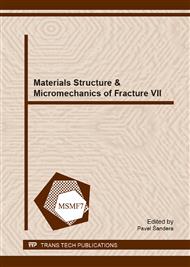p.87
p.92
p.96
p.100
p.107
p.113
p.117
p.121
p.125
A Contribution to the Physical Interpretation of the Morphology of Fatigue Fracture Surfaces
Abstract:
The reference texture is a subset of the image texture in SEM fractographs of fatigue fractures. It is common to all fractures caused by loadings in which significant events occur sufficiently regularly and frequently. The reference crack growth rate is unambiguously related to the reference texture. A particular loading is characterized by the ratio of the reference and conventional crack growth rates called reference factor. Its value may be related to the sequence of successive sizes of cyclic plastic zone, while the mechanism of the effect of overloads follows the models of Wheeler and Willenborg. Application to a set of three test specimens from stainless steel AISI 304L loaded by various loading regimes is shown.
Info:
Periodical:
Pages:
107-112
Citation:
Online since:
November 2013
Authors:
Price:
Сopyright:
© 2014 Trans Tech Publications Ltd. All Rights Reserved
Share:
Citation:


